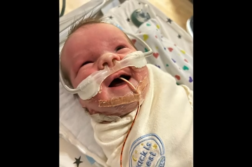SAN ANTONIO, Texas (Ivanhoe Newswire) – October is Breast Cancer Awareness Month. Triple negative breast cancer is aggressive and if not caught early, has a five-year survival rate of only 12 percent. Until now, doctors didn’t have much to fight the disease. But a new compound called ERX-41 is showing promise in knocking down triple negative, and other breast cancers.
Lynnette Dawson says, “I was first diagnosed with cancer in July of 2018. The doctors examined both my breasts and felt a lump on my left.”
Lynnette’s cancer has responded to chemo and radiation. She’s also had a double mastectomy. Lynnette has a form of cancer called HER2 that is hormonally driven. But triple negative breast cancer has no hormone receptors and is very hard to treat.
Professor OB/GYN at UT San Antonio, Ratna Vadlamudi, PhD, says, “I think if it’s a grade two or grade three, 50% of them will not survive within five years.”
Vadlamudi and his team tested 30,000 genes to find one to stop triple negative.
“What we found is ERX-41 binds to a new therapeutic target that is LipA,” Vadlamudi explains.
Once ERX-441 binds to the LipA gene, then, the cancer senses defective cells and dies off.
Vadlamudi adds, “They accumulate in the lumen, and the lumen sends a signal that something is wrong—stop everything.”
Researchers have found a breakthrough in mice. Normal breast cells are not affected by ERX-41, and there is no toxicity to the patient. It‘s also been effective against Lynnette’s subtype of cancer.
“HER2 positive is not the easiest. It likes to migrate to other parts of your body,” Lynnette tells Ivanhoe.
But if researchers have their way, there may be another potential option for women battling tough to treat breast cancers.
Professor Vadlamudi says ERX-41 has been effective in knocking down cancer in mice in 60 days. He also says the compound is likely to be effective against other lethal cancers like pancreatic, ovarian, and glioblastoma. Researchers expect human clinical trials to begin next year.
Contributors to this news report include Donna Parker, Producer; Bruce Maniscalco, Videographer; Roque Correa, Editor.
To receive a free weekly e-mail on medical breakthroughs from Ivanhoe, sign up at: http://www.ivanhoe.com/ftk
Source:
https://lern.la.gov/trauma/u-s-and-la-trauma-statistics/trauma-in-the-u-s/
MEDICAL BREAKTHROUGHS
RESEARCH SUMMARY
TOPIC: COMPOUND FIGHTS TRIPLE NEGATIVE BREAST CANCER: MEDICINE’S NEXT BIG THING?
REPORT: MB #5121
BACKGROUND: Triple negative breast cancer (TNBC) is a type of cancer that holds none of the receptors that are routinely found in breast cancers. TNBC is an aggressive cancer that spreads more quickly upon discovery and has a greater chance of coming back even after treatment Survival rates are significantly low in comparison with other types of breast cancers and patients are reported on average a 5-year relative survival rate after being diagnosed. There are limited treatment options available for TNBC because the cancer cells do not contain estrogen or progesterone receptors and lack HER2 protein. In these cases, this makes HER2 drugs and hormone therapies unavailable treatment options, allowing the cancer to spread more quickly.
(Source: https://www.cancer.org/cancer/breast-cancer/about/types-of-breast-cancer/triple-negative.html
DIAGNOSING: Triple negative breast cancer is furtive because there are times that no existing symptoms can be detected. Symptoms can imitate other forms of breast cancers though and common signs can include lumps and thickening in the breasts, redness and swelling, changes in breast sizes, nipple emissions, and pain or hardness in the breast region. TNBC is usually diagnosed upon negative test results of hormone receptors present: estrogen, progesterone, and HER2. Triple negative cancers are the most aggressive of the cancers and can spread rapidly upon diagnosis. The forms can alter notably from patient to patient and have a larger chance to recur. Confirmation of existing TNBC is crucial in determining a treatment plan. Many treatments for TNBC are advanced and highly detective screening tools include digital mammography, full breast tomosynthesis, magnetic resonance imaging, automated breast ultrasounds, and surgical biopsies.
(Source: https://moffitt.org/cancers/triple-negative-breast-cancer/diagnosis/
NEW TECHNOLOGY: There are fewer treatment options in comparison with other breast cancers; therefore, TNBC is often treated with chemotherapy. If the cancer is detected before it has spread surgery is a viable option, following chemotherapy. It is often recommended chemotherapy follow invasive surgeries to ensure the reduction of cancer returning. While anti-HER2 drugs and hormone therapies do not currently exist in treatment for TNBC, new drugs are going through trials that help the cancer cells perform cell apoptosis, or cell death.
(Source: https://www.cancer.org/cancer/breast-cancer/about/types-of-breast-cancer/triple-negative.html
FOR MORE INFORMATION ON THIS REPORT, PLEASE CONTACT:
Will Sansom Steven Lee
(210) 567-2579 lees22@uthscsa.edu
If this story or any other Ivanhoe story has impacted your life or prompted you or someone you know to seek or change treatments, please let us know by contacting Marjorie Bekaert Thomas at mthomas@ivanhoe.com



